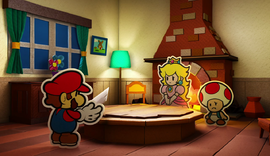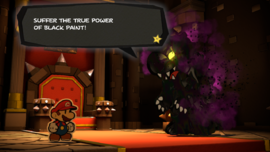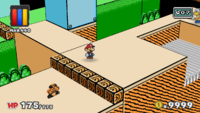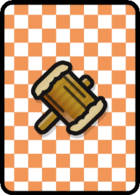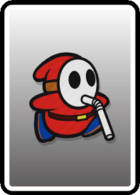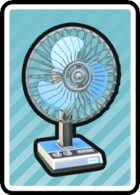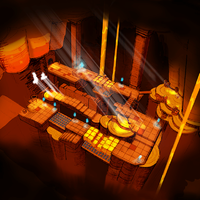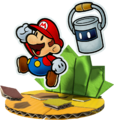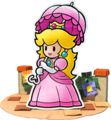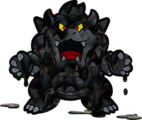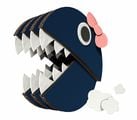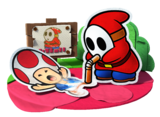Paper Mario: Color Splash: Difference between revisions
Scrooge200 (talk | contribs) (→Toads) |
Scrooge200 (talk | contribs) (→Toads) |
||
| Line 149: | Line 149: | ||
PMCS Foreman.png|'''[[Foreman]]''' | PMCS Foreman.png|'''[[Foreman]]''' | ||
Bloo Bay Beach barista PMCS sprite.png|[[Bloo Bay Beach barista]] | Bloo Bay Beach barista PMCS sprite.png|[[Bloo Bay Beach barista]] | ||
Green Energy Plant researcher PMCS sprite.png|[[Green Energy Plant researcher]] | |||
</gallery> | </gallery> | ||
Revision as of 00:54, January 21, 2021
Paper Mario: Color Splash is an action-adventure, turn-based role-playing game for the Wii U developed by Intelligent Systems. It is the fifth installment in the Paper Mario series, as well as the twentieth and final Mario game released for the Wii U. As a direct successor to the Nintendo 3DS game Paper Mario: Sticker Star, it expands on many gameplay elements introduced in that game. Its direct sequel, Paper Mario: The Origami King, was released for the Nintendo Switch on July 17, 2020.
Story
One stormy night, Princess Peach and Toad meet Mario at his house to deliver a strange letter: a Toad drained of his colors. The stamp on the letter points to Prism Island, where the three travel to. Upon arriving, they find the deserted Port Prisma full of spots drained of color. They also meet Huey, a mysterious 3D talking paint bucket, and find the cause of colorless spots to be Slurp Guys using straws to suck color out of things. Huey then asks Mario to squeeze him into paper form in order to use the power of paint to battle the Shy Guys and to repaint the colorless spots, including the local Toads. Discovering that the Big Paint Stars at Prisma Fountain are gone, Huey asks Mario to find them and return them to the fountain. However, the Koopalings are also on the island and have captured the Big Paint Stars, and Mario must find and defeat them.
The events that caused Port Prisma to be damaged and the black paint's creation are explained through the Big Paint Stars' memories, told throughout the game. Bowser had jumped into the fountain and mixed the paint together, wanting his shell to turn rainbow. This created black paint, which possessed him. The Koopa Troop attacked Port Prisma, stealing its paint and sending a Toad as a letter to get Mario and Peach to Prism Island. Peach sends Mario a series of Holo-Peaches, holograms of her telling Mario what Bowser is doing while she is captured.
After saving Port Prisma, Mario and Huey set out to find the red Big Paint Star. First, they pass through Ruddy Road and Cherry Lake, learning the Cutout ability and collecting 3D real-world objects called Things. They find out that Bowser has stolen the paint from the Crimson Tower, where Morton is keeping a Big Paint Star captive. To open the gate, they must find the three Chosen Toads: Justice Toad at Cherry Lake, Surfing Kinopio at Bloo Bay Beach, and the Mountain Sage at Daffodil Peak. Additionally, Mario learns about the Unfurl ability and assembles the green and purple Rescue Squads at Indigo Underground and Ruddy Road to help him reach more Mini Paint Stars. When all the Chosen Toads have been found, Mario defeats Morton at the Crimson Tower, painting in a large gate at Sunglow Ridge.
At Sunglow Ridge, Mario witnesses a black missile cover an area with black paint, which Huey cleans up while Mario's eyes are closed. He searches for Prof. Kinopio at Château Chanterelle, and finds him at Mondo Woods. The professor gives Mario an Excavation Site Permit, which he uses to enter Marmalade Valley. Here, Mario finds the professor's pet Chain Chomp, Princess, and brings her back to Château Chanterelle. The professor is happy and gives him the Sharp Spike as thanks. The spike unlocks the door to Kiwano Temple, which Mario must pass through to reach the Golden Coliseum, where Iggy is holding the yellow Big Paint Star. Mario defeats Iggy in a stadium battle and the Big Paint Star repaints an oversized coin in Mondo Woods.
Next, Mario investigates the mystery of ghosts haunting the Dark Bloo Inn, and explores the hotel's garden to find their Teapot to appease them. This leads him to Violet Passage, where he helps out the yellow Rescue Squad while on a pirate ship. The Rescue Squad go to the shrunken Sacred Forest to unclog a pipe. Here, Mario pieces together a Mini Paint Star and gains access to Cobalt Base, where he participates in Snifit or Whiffit. Next, Mario infiltrates Fort Cobalt to defeat Ludwig in his Super Ludship and Super Ludsub. The recovered blue Big Paint Star repaints the ocean at Violet Passage.
With the ocean restored, Mario has to join a ship crew and venture to Fortune Island to find the purple Big Paint Star. Using clues left behind by a legendary captain, they first pass through the Lost Sea. They stop at Vortex Island to calm down a whirlpool, then help out a lighthouse keeper on Lighthouse Island to light the way to Fortune Island. Mario makes use of parallel worlds on all three islands to find the treasure, but is confronted by Wendy before he can collect it. Defeating Wendy and collecting the Big Paint Star repaints a sinkhole at Mustard Café, which the café's owner falls into.
After rescuing the café owner from the hole, including escaping a Snifit jail, Mario hears of the Sunset Express train stuck at Kiwano Temple. The blue Rescue Squad help fix the broken tracks, only for the train to be damaged by a Big Thwomp. The Toads push the train to Toad Trainworks, where Mario repairs it. Next, the train goes to Tangerino Grill, where Mario cooks pizza for the Toads, and serves steak to a VIP customer (Larry). Larry hijacks the Sunset Express, and Mario defeats him with the help of the Toad train conductor. The train stops at Starlight Cape, where Huey makes a wish for the orange Big Paint Star; once it is granted, the Big Paint Star restores an unpainted Draggadon at Marmalade Valley.
After taming him, Mario guides Draggadon through Redpepper Volcano and platforms his way through Redpepper Crater to its hot spring. After returning to Tangerino Grill to get the Magnifying Glass Thing, he battles Kamek at the Sacred Forest. This opens a path to the Green Energy Plant, where Mario ventures into a Super Mario Bros. 3-like world to find a Mini Paint Star. He assembles the last members of the red Rescue Squad at Mossrock Theater, and visits the Emerald Circus, at which he meets Lemmy. Mario defeats Lemmy atop the circus tent, and saves the green Big Paint Star. It flies somewhere unknown and paints Luigi's kart.
Upon rescuing all six Big Paint Stars, they create a path to Black Bowser's Castle, where Mario and Huey head off to via a kart ride from Luigi. Inside they discover a factory producing Banzai Bills loaded with black paint, similar to the one dropped on Sunglow Ridge. After destroying the factory, they escape the flood of black paint and find Bowser with Princess Peach drained of her colors. As Mario battles Bowser, Huey has himself turned back into his 3D-self to absorb the black paint off and defeat Bowser, who has no memories of the incident. Black Bowser's Castle proceeds to collapse as Mario restores Peach's colors. Mario, Peach, and Luigi return to Port Prisma while Huey stays behind to contain the black paint and release it where it cannot do any more harm, to the skies. Later, while celebrating at Port Prisma, Peach comforts Mario when he laments Huey's disappearance. When all Super Flags are achieved, Huey can be seen falling back into the Prisma Fountain in the end screen.[1]
Gameplay
Paper Mario: Color Splash is an action-adventure RPG game that elaborates on the mechanics of Paper Mario: Sticker Star. It is based on Mario using the Paint Hammer to paint colorless elements, characters and parts of the environment in order to progress in the game and collect Mini Paint Stars and Big Paint Stars. When a course is completed, several new courses may become available at once, and the number-based course naming that was seen in Super Paper Mario and Paper Mario: Sticker Star is gone (the game features a sort of 'world map' like the latter though).
Super Flags return as well, this time found in the main square of Port Prisma. The battles are based on Battle Cards that can be painted to increase their effect. Said cards can be bought at the Prisma Cardware. Once used, cards are discarded, it is however possible to buy them directly in battle using the Battle Spin and choosing one of the flipped cards. There are three types of cards. Basic Cards are used for various purposes, including attacking, healing and replenishing paint. Many attacks are similar to those featured in Paper Mario: Sticker Star, with the hammer attacks now having a charging sign indicating at which point an "Excellent" attack can be obtained. Thing Cards, which do not deplete Mario's paint, are used to summon Things, both in battle and in the course to solve puzzles. Such cards can be obtained by directly squeezing Things into Thing cards. There is a shop in Port Prisma allowing the player to directly buy Things to squeeze them into Thing Cards, and there are Replica versions of Thing Cards as well. Finally Enemy Cards, dropped by defeated enemies, are used to summon an enemy into the battle as an ally. Only one ally can be present at a time. Such an ally attacks other enemies and, when the enemies attack, position itself in front of Mario to protect him, and stays in battle until defeated. However, it runs away in front of bosses.
At the beginning of a battle, Kamek can sometimes appear and either flip all the cards or steal many cards, once the battle is won, all the stolen cards are regained and additional coins are obtained as well. The number showing the HP of the enemies as well as the number showing the amount of damage dealt in HP are both missing, while the health of each enemy is shown in the form of color that is gradually drained starting from the bottom.
Both the use of the Paint Hammer and the painting of most cards requires paint, whose levels are indicated by bars. After winning a battle, defeated enemies can drop coins, paint, Battle Cards and cardboard hammers called Hammer Scraps. They exist in four different varieties and are worth 1 point, 5 points, 10 points and 20 points, depending on how much the colors are saturated and on the amount of glittery parts. Such points are used to fill a bar that when fully filled, increases the maximum amount of paint that can be carried.
It is also possible to permanently increase the number of cards playable in a turn during a battle by collecting special power-ups. Similarly, the maximum amount of Mario's HP can be increased by collecting HP-Up Hearts that are obtained when saving a Big Paint Star. Each HP-Up Heart increases the maximum amount of HP by 25 and increases the power of the First Strike as well.
| Big Paint Star obtained | Max HP | Power of First Strike (Damage in HP) | |
|---|---|---|---|
| Jump | Hammer | ||
| None | 50 | 3 | 3 |

|
75 | 5 | 6 |

|
100 | 7 | 9 |

|
125 | 10 | 11 |

|
150 | 13 | 13 |

|
175 | 14 | 14 |

|
200 | 15 | 15 |
In order to gain additional coins, there are side quests and mini-games that can be played. One of them is finding Luigi who is hiding in some places, another is playing Super Roshambo against several opponents at the Roshambo Temples, a further one is fighting and defeating The Shy Bandit on the world map.
Furthermore, it is possible to use a move similar to paperization called "Cutout" in order to cut part of the courses. Likewise, the Flip technique from Super Paper Mario returns as well, in a course dedicated to Super Mario Bros. 3 found at the Green Energy Plant. Key items also return.
Characters
Playable
Allies
Toads
- PMCS PiperAndToads.jpg
Bosses
| Image | Name | Description |
|---|---|---|

|
Morton | The guardian of the red Big Paint Star, battled atop the Crimson Tower. Morton calls in two Shy Guys with a pedestal and stands atop it during his battle. Once Mario defeats the two Shy Guys and knocks away the pedestal with a hammer attack, Morton pulls out a flaming hammer, which has to be countered with the Fire Extinguisher Thing. |
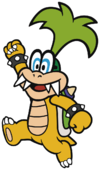
|
Iggy | Iggy is fought in the Golden Coliseum as part of a "Battle Royal" event. In battle, Iggy rides a chariot, driving away when Mario tries to attack. Mario has to use the Bone Thing and have Princess destroy Iggy's chariot, as well as the Chariot Bro and Chariot Snifit accompanying him. Once Iggy is defeated, Mario is rewarded with the yellow Big Paint Star. |
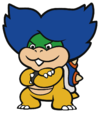
|
Ludwig | Ludwig is found in Fort Cobalt with the blue Big Paint Star. He rides the Super Ludship, which is invulnerable to attacks; Mario must reflect Ludwig's projectiles with Tail attacks to destroy the ship. However, Ludwig resurfaces in the Super Ludsub, hiding in the water and firing missiles. The Balloons Thing must be used to lift the sub out of the water. |
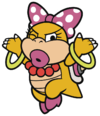
|
Wendy | As the boss of Fortune Island, Wendy protects the purple Big Paint Star. She attacks by throwing enemies and coins at Mario, eventually preparing a giant ring to trap him. If Mario uses the Instant Camera Thing, he prints out a picture of himself, which Wendy attacks instead. |

|
Larry | Larry is fought on the Sunset Express while it is heading to Starlight Cape. A Shy Guy supplies Larry with healing hearts through the smokestack, as the Sunset Express's conductor goes down to the cabin to stop it. Once the Shy Guy is defeated, Mario can plug the smokestack with the Cork Thing, making Larry vulnerable. After Larry is defeated, the conductor takes control of the train again and stops near the orange Big Paint Star at Starlight Cape. |
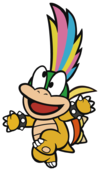
|
Lemmy | As a performer at the Emerald Circus, Lemmy battles Mario on top of the circus tent while guarding the green Big Paint Star. Lemmy is the only Koopaling that requires two Things to be weakened; while he is spinning on the Wonder Ball, Mario has to use the Disco Ball Thing to distract him, then pop the ball with the Ice Pick Thing. |

|
Roy | Roy is the only Koopaling that does not guard a Big Paint Star, instead being fought at the beginning of Black Bowser's Castle. Roy steals all of Mario's paint and shoots it back at him through a cannon, causing unique status effects. After taking enough damage, Roy mixes the paint together and covers the room in black paint; this can be removed with the Washing Machine Thing. |

|
Black Bowser | Black Bowser is the final boss of Paper Mario: Color Splash, appearing at the end of Black Bowser's Castle. For the first phase of the fight, Mario has to damage Black Bowser until his head is free of black paint; he appears shocked and unaware of what he has been doing. The black paint then covers Bowser again as he enlarges in size. Huey reverts into 3D and has Mario time his blocks perfectly to absorb the black paint. As a final attack, Black Bowser spits all the black paint into a giant ball, then fires it at Mario; if blocked, Huey is damaged, although Mario is able to finish off Bowser. |
Mini-Bosses
| Image | Name | Description |
|---|---|---|

|
Big Spiny | A large Spiny fought in Kiwano Temple. |
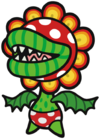
|
Petea Piranha | A version of Petey Piranha who is hiding in the Teapot at Plum Park. Once defeated, the park's waters are purified and Mario can collect the Teapot. |
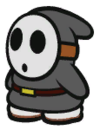
|
Black Shy Guy | A Shy Guy in a black cloak who speaks in haiku and ambushes Mario in Violet Passage. |

|
Steak | A live-action slab of meat battled at Tangerino Grill. Mario must use a correct series of attacks and Things to cook the steak, and then serve it to a VIP customer. |
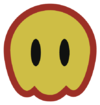
|
Big Lava Bubble | A giant Lava Bubble battled in Redpepper Crater. A Shy Guy accompanies it to translate its speech. |
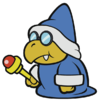
|
Kamek | Kamek is fought directly in the Sacred Forest after enlarging a pipe with the Magnifying Glass Thing. He casts spells on Mario to hinder him throughout the battle. |

|
Shy Bandit | A recurring mid-boss who appears on the world map. The Shy Bandit throws his calling card to a spot on the map and begins slurping the color out of the area. If Mario catches him first, he enters a battle. The Shy Bandit attacks like a regular Slurp Guy, but can also summon reinforcements. |
Enemies
- Main article: Paper Mario: Color Splash bestiary
|
|
Other
- Draggadon
- Yoshis (Red, Green, Light Blue, Yellow, Pink, Purple, Orange)
- Banzai Bill
- Mega Bob-omb
- Volcanic debris
- Bullet Bill
- Bill Blaster
Locations
Template:PMCS Prism Island Map The game is set on Prism Island, shaped like a paint brush, and on nearby islands, similar to drops of paint, which have been drained of their color. The locations are organized according to the game's seven main colors, with the three primary colors (red, yellow and blue) and the three secondary colors (violet, orange and green) having each four courses and a course with a main boss, Port Prisma being dedicated to the game's three primary colors and Bowser's Castle being dedicated to the game's tertiary color, black. The map is colored in as Mario collects Mini Paint Stars, though it is not possible to view it completely colorless, as the world map is only unlocked after Mario collects the red Mini Paint Star from Port Prisma.
Locations include:
| Course | Red | Yellow | Blue | Violet | Orange | Green | Black | Blue, red and yellow | Various colors |
|---|---|---|---|---|---|---|---|---|---|
| 1 | Ruddy Road | Daffodil Peak | Indigo Underground | Plum Park | Marmalade Valley | Mondo Woods | Black Bowser's Castle | Port Prisma | Roshambo Temples |
| 2 | Cherry Lake | Sunglow Ridge | Bloo Bay Beach | Violet Passage | Kiwano Temple | Sacred Forest | |||
| 3 | Redpepper Volcano | Château Chanterelle | Dark Bloo Inn | Vortex Island | Toad Trainworks | Green Energy Plant | |||
| 4 | Redpepper Crater | Mustard Café | Cobalt Base | Lighthouse Island | Tangerino Grill | Mossrock Theater | |||
| Boss | The Crimson Tower | The Golden Coliseum | Fort Cobalt | Fortune Island | Sunset Express | The Emerald Circus |
Items and Objects
General
Key items
| Image | Name | Description |
|---|---|---|

|
Toad's Pants | One of Justice Toad's items at Cherry Lake. They are found stuck in a tree. |

|
Toad's Shoes | One of Justice Toad's items at Cherry Lake. They are found in a bush. |

|
Toad's Vest | One of Justice Toad's items at Cherry Lake. It is stuck in a piece of wood. |

|
Hero's Journal | One of Justice Toad's items at Cherry Lake. It is stolen and read aloud by Pry Guy. |

|
Blissful Beach Key | The key to Blissful Beach. It is won from the Toad Shuffle event at Bloo Bay Beach. |

|
Tea Recipe Book | A book found in the Dark Bloo Inn. It must be given to a Tea Party Toad to appease him. |

|
Birdcage | A birdcage found in room 303 in the Dark Bloo Inn. |

|
Caged "Bird" | A Koopa Paratroopa in the Birdcage. It is used to appease a Tea Party Toad at the Dark Bloo Inn. |

|
"It" | Yoshi, who is initially invisible. "It" is captured by a Shady Sledge Bro and his group near the Dark Bloo Inn, and must be returned to its Tea Party Toad owner. |

|
Fresh Sheets | Bedsheets found in the linen closet of the Dark Bloo Inn, given to a Tea Party Toad in room 301. |

|
Mountain Climbing Permit | A permit required to climb Daffodil Peak and find the Mountain Sage. Mario must cheer up the park ranger by repainting his cabin in order to get the Mountain Climbing Permit. |

|
Excavation Site Permit | A permit needed to enter Marmalade Valley, given by Prof. Kinopio so Mario can look for Princess. |

|
Sharp Spike | A spike similar to one on a Spiny's shell, rewarded by Prof. Kinopio and used to enter Kiwano Temple. |
| Paint Star Pieces | Five pieces of a Mini Paint Star, torn apart by a Small Goomba Gang and scattered around Sacred Forest. | |

|
Magma Burger | A spicy burger sold at the Prisma Café in Fort Cobalt. It is used to lure Draggadon at Redpepper Volcano. |

|
Fishing Pole | A fishing rod sold as a combo with the Magma Burger. It is used with the Magma Burger to guide Draggadon. |
| Journal Entries | Five journal entries written by the legendary captain, scattered around the ship at Violet Passage. | |

|
Letter from Chest | A note found on Fortune Island, informing Mario and Huey that the Instant Camera has been taken by Snifit or Whiffit. |

|
Snifit's Card Key | A key card needed to use the elevator in the Snifit Undersand Hideout, found underneath a sofa on the bottom floor. |

|
Café Key | The key to the Mustard Café, stolen by Snifits. Mario needs to bring it to the Mustard Café chef to open the café and get the Mini Paint Star inside. |

|
Trunk Key | The key to a trunk on the Sunset Express, containing 30 members of the red Rescue Squad and obtained after defeating some Snifits. |
Battle Cards
- Main article: Battle Card (Paper Mario: Color Splash)
Nintendo eShop description
A mystery is afoot on Prism Island and only Mario™ can solve it——by restoring the land's vanishing colors with his new Paint Hammer. Puzzling battles await, but never fear; there's always a clever way to dish out the powerful Battle Cards up his sleeve. These fresh layers of strategy make this one of the most action-packed Paper Mario™ adventures ever!
It all begins when Mario receives an odd letter in the mail and heads for the unknown in a small boat. What he finds is a series of hilariously mysterious moments, each a clue that inches him closer to answering the riddle of Prism Island. To restore its former glory, he must first rescue the Big Paint Stars. Luckily, Mario's new companion Huey has granted him the power of paint, which can be used to recolor the exotic locales he'll hit up on his journey. Examine environments for clues, revive color-drained Toads, and even participate in strange events like the game show "Whifit or Snifit." Whatever it takes to make a splash on Prism Island!
Pre-release and unused content
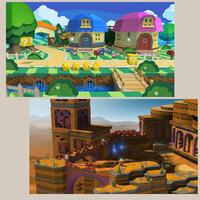
The game features a concept art gallery in which concept art is gradually unlocked by donating Battle Cards to the museum. The concept art allows players to see how the characters, objects and settings were gradually changed during development. It also reveals two locations that were cut from the game.
The first location is the east side of Decalburg, from the previous game, that would have featured new objects, including postboxes, differently placed Coins and ? Blocks and, most importantly a river with sewage pipes, that it would have been possible to cross using a bridge to reach an area not present in Paper Mario: Sticker Star. The second one is an unused location similar to a temple in a mountainous area of a rocky desert, that would have featured blue torches and at least three buildings connected by staircases and bridges. Many warp pipes would have been present as well, as in the concept art five of them can be observed, of which four are in a row.
The unused location on the inside would have featured blue torches, cacti, sandfalls, broken walls that allow some light to enter, drawings of a Coin, a mushroom and a star on the walls, very high pillars, bridges made of blocks of a different material, possibly sand, and spiked pits, thus making it similar to Kiwano Temple, suggesting, along with the rocky desert setting, that this unused location might have been a preliminary version of said location.
Staff
- Main article: List of Paper Mario: Color Splash staff
Promotion
A game on the Play Nintendo website was released in 2016 called Paper Mario: Color Splash Trivia Quiz.
Reception
Critical reception
Upon being shown at the March 3, 2016 Nintendo Direct, Paper Mario: Color Splash received negative reception from some fans, the main complaint focusing around the game's similarities to Paper Mario: Sticker Star. Within hours of the game's reveal, a petition on Change.org ordered the game to be canceled, which TechRadar described as "a frightening example of how quickly, and harshly, we judge games we know next to nothing about."[2]
Despite this, the game received generally positive reviews at release. Most critics praised the game's art direction and humorous writing, though the lack of original characters and still-simplistic storyline were points of contention. In addition, while several reviewers noted gameplay improvements from Paper Mario: Sticker Star, some elements still drew criticism, such as the battle system and linear level design.
| Reviews | |||
|---|---|---|---|
| Reviewer, Publication | Score | Comment | |
| Terri Schwartz, IGN | 7.3/10 | "Paper Mario: Color Splash is a step in the right direction for the series after the 3DS’s Paper Mario: Sticker Star, continuing its shift from RPG to action-adventure game while also introducing some smart changes to its battle system. The beautiful Wii U graphics and playful humor stay true to the spirit of the Paper Mario franchise, but the story is straightforward and a bit bland. Inventive level design in the second act offers some much needed diversity to some of Color Splash's otherwise linear gameplay before the disappointing third act regresses into simple and uninteresting battles. Though Color Splash still isn't back to the high points of the first three games in the Paper Mario series, it's a strong step in the right direction." | |
| Miguel Concepcion, GameSpot | 7/10 | "At its most imaginative, Color Splash's visual gags and thoughtful manipulation of 2D objects rival any "wow" moment from Sony's Tearaway games. What Color Splash lacks in moment-to-moment paper tricks, it more than makes up for in persistent visual appeal and a wholly adorable cast, including antagonists from all pay grades. Its only frustrating feature is its Cutout interface, which can leave one stumped, disrupting the game's pacing and enjoyment of levels considerably. The novelty of the paint splashing doesn't grow tiresome, but it does take a backseat to the visual allure for which the series is known. Color Splash makes a solid case for a Paper Mario sequel that doesn’t need to rely on shtick like stickers or paint, though I won't be surprised if Nintendo’s considering using crayons in the future." | |
| Ben Reeves, GameInformer | 8.5/10 | "Color Splash’s RPG elements might be paper thin, but fans of the series won’t be disappointed with this latest adventure. While the game’s combat isn’t much deeper than Mario’s paper-thin body, this plumber’s antics and colorful world are worth the price of admission." | |
| CJ Andriessen, Destructoid | 8.5/10 | "If you didn't like Paper Mario: Sticker Star because it wasn't like the first two games in the series, I don't think you'll be satisfied here. For everyone else willing to give it a chance, Paper Mario: Color Splash is a charming journey that will delight your senses, your funny bone, and the part of your brain that houses your nostalgic feelings towards Nintendo." | |
| Emma Schaefer, EGM | 8/10 | "Color Splash presents a beautifully crafted paper and cardboard world, populated by witty paper Toads and existential minions. Though it’s got its share of backtracking and battle system quirks, the new painting mechanics are satisfying, and the mini-story arcs are almost creative and clever enough to make you forget that your princess is (yet again) in another castle." | |
| Aggregators | |||
| Compiler | Platform / Score | ||
| Metacritic | 76 | ||
| GameRankings | 76.25% | ||
Sales
In its opening week - October 10 through 16, 2016 - Paper Mario: Color Splash sold 20,894 copies in Japan.[3] It left the top 20 after the week of October 31 with 37,093 copies sold.[4] Famitsu reported the game as selling a total of 65,316 copies over its entire lifetime in Japan, making it one of the lowest-selling retail Mario games in the country[5].
Similarities to other Paper Mario games
- Huey is Mario's companion in the game, fulfilling the role of Goombario from Paper Mario, Goombella from Paper Mario: The Thousand-Year Door, Tippi from Super Paper Mario, Kersti from Paper Mario: Sticker Star, and Olivia from Paper Mario: The Origami King.
- Huey turns himself into a Battle Card to help Mario defeat Bowser, similar to how Kersti sacrificed herself by turning into a sticker during the final boss in Paper Mario: Sticker Star.
- Bowser returns as the main antagonist, like he was in Paper Mario: Sticker Star.
- Also, the black paint controls Bowser and makes him more powerful, much like the Royal Sticker in Paper Mario: Sticker Star.
- There is a level in which Mario must go on a game show.
- Snifit or Whiffit returns from Paper Mario: Sticker Star with new games involving Battle Cards.
- Mini Paint Stars function like the Comet Pieces from Paper Mario: Sticker Star.
- Battle Cards replace stickers.
- Jumps, Hammers, their Worn-Out variants, Line Jumps, Hopslippers, Iron Jumps, Eekhammers, Hurlhammers, Blazehammers, Fire Flowers, Ice Flowers, POW Blocks, Mushrooms, Tails, Spike Helmets, and Frog Suits all return from Paper Mario: Sticker Star.
- Things from Paper Mario: Sticker Star return, including the Fan, Cat-o-Luck, Basin, Lightbulb, and the Hair Dryer, along with the Teapot, although it has a different appearance.
- Like in Paper Mario: Sticker Star, Luigi can be found hiding in some levels.
- Like previous home console installments of the Paper Mario series, the game starts at the Mario Bros.' House.
- Much like Paper Mario: The Thousand-Year Door and Super Paper Mario, there is a generic enemy character named Johnson. In the former games' cases, he was an X-Naut and a Koopa Troopa respectively, whereas in this game, Johnson is a Shy Guy.
- Bowser's castle floats, like it does in Paper Mario and Paper Mario: Sticker Star.
- A parade takes place during the ending credits, just like in Paper Mario and Paper Mario: Sticker Star.
- Luigi leads the parade, just like in those games.
Differences from other Paper Mario games
- Lakitus are completely absent from this game, though they are mentioned by Luigi.
- While fought, enemies say phrases to provoke Mario.
- Parakarry makes no appearance in any form and is not mentioned in any version either.
- As a result, this is the first game to not reference a partner from a previous game in any version.
- A giant Blooper does not appear as a boss or mini boss.
- There is no story-related recurring mini boss.
- The HP of enemies cannot be seen. However, when attacking an enemy, paint is drained from the enemy, indicating the amount of health remaining.
- The amount of damage inflicted on enemies can also not be seen.
- There are no individual save files.
- Players can only remove save data through the settings.
- When Mario hits a Save Block, the game does not ask the player if they want to save, instead automatically saving the game by default.
- There are no Recovery Blocks.
- The heads-up display (Heart Points and coins, and the Paint Meter in this case) no longer disappears after a short time when Mario does not collect anything or is hurt.
- When Mario collects a coin, the counter only bounces slightly instead of flashing three times.
- When Mario collects a Big Paint Star, his maximum HP increases by 25 points. Comparatively, in previous Paper Mario games, Mario's health only increased by 5 points at a time (either after leveling up or collecting an HP-Up Heart).
- Unlike in Paper Mario: Sticker Star, where several Things can be used for the same puzzle, only one set Thing is required to change a level.
- When getting a Perfect Bonus, it is no longer based on clearing the battle in one turn without taking damage, but rather not sustaining damage throughout the entire battle.
- Characters and enemies in this game have a more papery appearance than in the rest of the Paper Mario series. They have a white outline, similar to Mario & Luigi: Paper Jam, and they have no shading on their colors.
- This is the only Paper Mario game where Boos are enemies, but no Big Boo variations are present.
- This is the only Paper Mario game to have only one shop, which gets updated throughout the game; other games have multiple shops found in different areas.
- This is the first Paper Mario game to contain an unlockable post-credits scene.
References to other games
- Super Mario Bros.: The Goal Pole makes an appearance in both the 8-bit sprite from said game which appears in Green Energy Plant and in Black Bowser's Castle. The Springboard uses this games sprite in Green Energy Plant as well. A Toad in the audience of Emerald Circus throws the Super Mushroom sprite from this game and Mario uses his idle based on his sprite while he grows.
- Super Mario Bros.: The Lost Levels: When Huey realizes that the red Mini Paint Star in Ruddy Road has lost most of its color, he exclaims, "What in The Lost Levels is going on here?"
- Super Mario Bros. 2: The overworld music is rearranged, titled "Spinning-Door Game." The vases also make an appearance in Château Chanterelle. Wart is mentioned in the game by a yellow Toad at Sunglow Ridge.
- Yume Kōjō: Doki Doki Panic: At the concert in Plum Park, Birdo sings the line "two hearts in doki doki panic," referencing her first appearance in this game.
- Super Mario Bros. 3: The Angry Sun is mentioned by one of the Five Fun Guys during Toad and Go Seek, and again by the Roshambo announcer while introducing Green Pokey. It is mentioned again when the Roshambo Temple announcer introduces Green Pokey. The Green Energy Plant is based on this game. When accessing the level, the soundtrack during normal gameplay is taken directly from the NES game, although flipping to 3D mode has it instead play a slightly orchestral cover. When Mario and Huey confront Larry on top of the train and the latter explains his motives, he makes clear he us doing his actions regarding hijacking the train to get the orange Big Paint Star solely to make sure Bowser isn't upset otherwise, which is what Larry stated in the Japanese manual for the game. The Recorder from this game (which, in turn, is from the original The Legend of Zelda game) appears as its 8-bit sprite in Green Energy Plant and can be squeezed into a more realistic-looking Thing Card; when used, the original notes are played by the flute itself, and it has the same effect of summoning a whirlwind, while three other flutes play the "Coin Heaven" theme in the background. Additionally, to board the airship, Mario hangs on an anchor, similar to how he did in this game. The Shy Guy Stack in Cherry Lake, upon seeing Mario, says, "HA! It looks like your upper lip found a Tanooki Suit!" Peach also uses Holo-Peachs to send Mario tips during the game after beating the various Koopalings, similar to her letters from Super Mario Bros. 3. Also like in that game, she'll be unable to send a message to Mario after all objectives have been completed, although for different reasons (in Super Mario Bros. 3, Bowser sends a letter in her stead stating he kidnapped her again. In Color Splash, her message is cut off via Black Bowser draining her color off-screen).
- Super Mario Land: An arranged version of the credits theme is present in the Roshambo Temples.
- Dr. Mario series: After talking to the injured Purple Rescue Squad member on Daffodil Peak, if the player talks to Huey before helping the Toad, he'll mention Mario part timing as a doctor.
- Super Mario World: Dino Rhinos return from this game.
- Paper Mario: The jingle played when collecting a Big Paint Star is remixed from the first few notes of this game's opening theme.
- Luigi's Mansion series: One of the Toads in Dark Bloo Inn references Luigi's role in these games, noting that he has dealt with paranormal activity before.
- Paper Mario: The Thousand-Year Door: The running gag that originated from this game in which an implied grunt character is referred to as Johnson returns after being absent from Sticker Star. Additionally, Port Prisma has an almost identical layout to Rogueport, with a staircase leading to the square where the major collectibles of the game are put in place in Prisma Fountain, like in Rogueport Sewers. In addition, Peach sends messages to Mario like in that game, and was ultimately responsible for getting him to the main area of the game in the first place, and late into the game, she also has her message cut off due to interference from the primary antagonist. The Hero's Journal looks similar to Goombella's Tattle Log.
- Super Paper Mario: Mario can use flip in the Super Mario Bros. 3 part of Green Energy Plant in a similar way to this game.
- Mario Party 8: The Five Fun Guys troupe name originates from the Mario and Toad team name featured in this game.[6]
- Mario Party 9: Toad and Go Seek is named after a minigame from this game.
- New Super Mario Bros. Wii: Iggy taunts Mario by slapping his behind, like in this game. A Junior Clown Car, which is shown to be Koopa Clown Car in concept art, is seen in the back room of The Emerald Circus.
- Paper Mario: Sticker Star: Many of this game's elements and physics return. Photographs of the Yoshi Sphinx, a location in World 2, and Hither Thither Hill can be seen on the left wall in Dark Bloo Inn's lobby. Also, sound effects from this game are recycled. The music for Bowser's introduction is also the same music used for his introduction from the same game. When Mario gets a Big Paint Star, the music that plays when the areas color is restored is the same theme that plays when the flashbacks explaining how each of the bosses in that game got their respective Royal Stickers. Also, there are plenty of music tracks from this game that are remixed. The Koopalings' introduction themes were also taken from the Warning themes for the "Sticker Star" boss introductions. Snifit or Whiffit is also taken from this game as well. The fight against Wendy is a music-based fight similar to the Gooper Blooper battle in this game. Huey turning into a battle card mirrors Kersti turning into a sticker.
- Mario Kart series: Luigi appears driving a Standard Kart modeled after the ones from Mario Kart 8. Additionally, the "Luigi's death stare" meme, which originated from that game, is referenced. Also, the title theme and the countdown timer to begin racing are taken from this game as well. Rainbow Road appears in the game and the music of that course is a remix from Mario Kart 64. When Luigi decides to floor it to rush to the castle despite its creepy appearance, he states they'd better be careful, stating Lakitu isn't there to save them this time around, alluding to how various characters in the Mario Kart series, if caught in various hazards (falling into water, quicksand, lava, or bottomless pits) is fished out by Lakitu and brought back onto the main course. After being beaten, Bowser asks Mario if he's at Black Bowser's Castle because they have a kart race scheduled for the day, referencing the Bowser's Castle tracks in the series. Just before leaving Black Bowser's Castle in the ending, Luigi reassures Mario that Huey is alright, mentioning that he fell off Rainbow Road lots of times, alluding to the difficulty of the courses in the game.
- New Super Mario Bros. U: Similar to the ending of this game, the Koopalings and Bowser's last appearance before the credits was them and their already damaged airship crash landing. Unlike in this game, however, it crashing was not Bowser's fault, as it got hit by a stray firework. Morton Koopa Jr. has his Hammer (based on Mario's) and Roy Koopa has his Bill Blaster for their respective fights.
- Captain Toad: Treasure Tracker: Draggadon makes his paper debut. After using the Basin Thing in Redpepper Volcano, a bump comes out of its head, just like in this game after a rock falls on it. Also, when this happens, Mario can ride Draggadon as Captain Toad does in this game. One of the yellow Rescue Squad members says they used "sophisticated Toad treasure-tracking technology" to track a stolen bone from Marmalade Valley to The Golden Coliseum.
- Mario & Luigi: Paper Jam: Enemies can sometimes appear in stacks, just as the paper enemies do in this game. Also, the Koopalings have their first paper appearances, after it being foreshadowed by Roy and Wendy in this game.
References in later games
- Super Smash Bros. Ultimate: The battle theme from Paper Mario: Color Splash appears in this game. Additionally, Huey appears as a Spirit, and Petea Piranha is mentioned in Piranha Plant's Palutena's Guidance.
- Mario & Luigi: Bowser's Inside Story + Bowser Jr.'s Journey: In Bowser Jr.'s Journey, having Morton Koopa Jr. as a First Officer in the player's team changes the team's name to "More Tons", a phrase Morton uses in several of his dialogues in Paper Mario: Color Splash.
- Paper Mario: The Origami King: This game runs on a similar graphic engine, with many character appearances and text box sound effects being reused. A Shy Guy with a straw appears in Shogun Studios. The music for Fortune Island plays when Mario meets Captain T. Ode. An image of Princess Peach's appearance from this game appears in The Princess Peach alongside images of her other appearances in the series.
Gallery
- For this subject's image gallery, see Gallery:Paper Mario: Color Splash.
Media
- Main article: List of Paper Mario: Color Splash media
Names in other languages
| Language | Name | Meaning |
|---|---|---|
| Japanese | ペーパーマリオ カラースプラッシュ Pēpā Mario Karā Supurasshu |
Paper Mario: Color Splash |
| Chinese (traditional) | 紙片瑪利歐Colour Splash[7] Zhǐpiàn Mǎlì'ōu Colour Splash |
Paper Mario: Colour Splash |
| German | Paper Mario: Color Splash |
Paper Mario: Color Splash |
| Italian | Paper Mario: Color Splash |
Paper Mario: Color Splash |
Trivia
- The seven main colors on which the game is based (red, yellow, and blue as the primary colors; violet, orange, and green as the secondary colors; and black as the tertiary color) are actually the colors of the Koopalings' Magic Wands, first introduced in Super Mario Bros. 3 in 1988.
- On September 23, 2016, it was discovered that purchased Nintendo eShop pre-load data was actually the full game, granting players early access two weeks ahead of schedule in North America.[8] Nintendo, however, removed the pre-order option within hours, and stated that this was inadvertent.[9]
- In some English-speaking countries (e.g. the United Kingdom and Australia), the correct spelling for color is "colour". Despite this, the title was not changed outside of the Americas to reflect this difference.
External links
References
- ^ Crunchii. (September 30 2016) [Spoilers] 100% Ending - Paper Mario: Color Splash. YouTube. Retrieved October 30, 2016.
- ^ http://www.techradar.com/news/gaming/paper-mario-color-splash-has-been-around-30-minutes-and-people-already-hate-it-1316232
- ^ Romano, Sal. Media Create Sales 10/10/16 - 10/16/16 (October 19, 2016). Gematsu. Retrieved October 23, 2016.
- ^ Romano, Sal. Media Create Sales: 10/31/16 – 11/6/16 (November 9, 2016). Gematsu. Retrieved August 10, 2019.
- ^ https://sites.google.com/site/gamedatalibrary/game-search
- ^ McWhertor, Michael (June 23, 2016). Nintendo denies Paper Mario: Color Splash makes jokes about 'online hate campaign'. Polygon. Retrieved July 26, 2017.
- ^ Official Chinese website for the Super Mario Bros. 35th Anniversary. Retrieved October 23, 2020.
- ^ http://www.polygon.com/2016/9/23/13028328/paper-mario-color-splash-leaks
- ^ http://kotaku.com/nintendos-big-fall-wii-u-game-briefly-went-on-sale-two-1786995541
